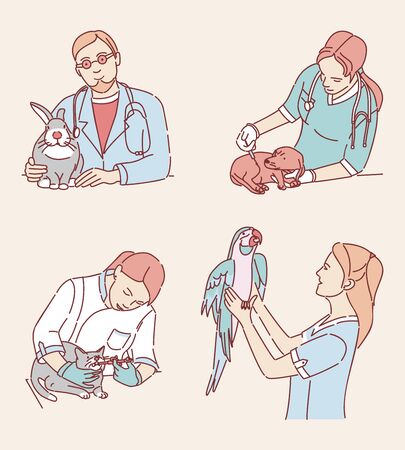Understanding Exotic Pet Insurance
If you’re the proud parent of a feathered, scaled, or otherwise unique companion, you know that caring for exotic pets is a whole different ball game compared to traditional cats and dogs. That’s where exotic pet insurance steps in—a specialized safety net designed just for your extraordinary critters. Unlike standard pet insurance policies that cater mostly to dogs and cats, exotic pet insurance is tailored to cover birds, reptiles, amphibians, small mammals like ferrets or hedgehogs, and even some invertebrates. This type of coverage recognizes the unique health needs and risks associated with these animals. From avian vet visits to specialized reptile care, the policies are crafted with a deep understanding that your cockatiel or bearded dragon isn’t just another “pet”—they’re family. With this kind of insurance, American pet parents can access veterinary care that might otherwise be costly or hard to find, giving peace of mind and helping your unusual companions thrive for years to come.
2. Which Pets Are Considered Exotic?
If you’ve ever strolled through a local American farmer’s market or visited a neighbor’s backyard, you might notice more than just dogs and cats keeping folks company. From the vibrant chatter of parrots to the gentle curiosity of rabbits, American households are increasingly home to a delightful mix of unconventional companions. But when it comes to pet insurance, what exactly qualifies as an “exotic” pet?
In the United States, most pet insurance companies define exotic pets as any animal that isn’t a dog or cat. This broad definition covers a surprising variety of species. While some insurers get quite specific, most commonly insured exotic pets include birds (like cockatiels and parrots), reptiles (such as snakes, lizards, and turtles), small mammals (like rabbits, ferrets, guinea pigs, and hamsters), and even amphibians or pot-bellied pigs.
Common Exotic Pets Covered by Insurers
| Pet Type | Example Species | Typical Coverage Availability |
|---|---|---|
| Birds | Parrots, Cockatiels, Canaries | Available with select providers |
| Reptiles | Snakes, Lizards, Turtles | Varies by insurer; less common than for birds |
| Small Mammals | Rabbits, Ferrets, Guinea Pigs, Hamsters | Frequently available from specialty insurers |
| Pocket Pets | Mice, Rats, Gerbils | Mainly through specialized plans |
| Amphibians & Others | Frogs, Pot-bellied Pigs | Rare; check with individual providers |
This variety means you can find coverage for many animals beyond the standard furry friends. However, each insurer has its own list of eligible species—some will cover your blue-tongued skink or sugar glider, while others may only insure more common exotics like rabbits and parrots. Always double-check with your chosen provider before bringing home a new scaly or feathered family member!

3. Types of Coverage Available
When it comes to insuring exotic pets like parrots, iguanas, ferrets, and sugar gliders here in the U.S., pet insurance policies offer a variety of coverage options tailored to their unique needs. While traditional dog and cat insurance is widely available, coverage for exotic animals can be a bit more specialized—think of it as finding just the right hay blend for your guinea pig or the perfect basking lamp for your bearded dragon! Here’s what you can expect when exploring policy options:
Accident and Emergency Care
This is the most common type of coverage for exotic pets. Policies typically help with unexpected injuries or sudden illnesses—maybe your parrot takes a tumble from his favorite perch, or your turtle gets into something he shouldn’t have. These plans often reimburse you for emergency vet visits, diagnostic tests (like x-rays or blood work), surgery, and hospitalization. For many pet parents, this peace of mind is priceless when accidents happen out in the backyard or inside our cozy country homes.
Illness Coverage
Exotic pets sometimes come down with illnesses that require specialized care—think respiratory infections in reptiles or feather-plucking disorders in birds. Illness coverage helps offset costs related to treatment, medications, and follow-up exams. This is especially important since finding an experienced exotic animal vet can already be a challenge in some rural areas!
Routine and Preventive Care
Some insurers offer add-on plans or wellness packages that cover routine checkups, annual exams, vaccinations, nail trims, and even dietary consultations. While not all policies include preventive care by default, adding this option can be helpful if you want regular health assessments for your cockatiel or yearly parasite screenings for your hedgehog. It’s a bit like scheduling spring cleaning on the farm—prevention is key!
Coverage Limitations & Exclusions
Just as every animal has its quirks (my goats sure keep me guessing!), every insurance policy has limits. Most do not cover pre-existing conditions, cosmetic procedures, breeding-related expenses, or elective surgeries. Some rare species may not be eligible at all. Always read the fine print—knowing exactly what’s included ensures you’re prepared whether you have a talkative macaw or a slinky corn snake.
Choosing What’s Right for Your Flock
No two exotic pets—or pet families—are alike. Take time to compare providers and ask about species-specific coverage. Whether you live on acres of land with a menagerie of critters or share your apartment with a single gecko, there’s likely a plan that fits your needs and offers that extra layer of security we all want for our beloved companions.
4. Common Exclusions and Limitations
When you’re shopping for exotic pet insurance in the U.S., it’s important to know that not everything is covered under a typical policy. Companies often list a range of exclusions and limitations, especially when it comes to birds, reptiles, and other non-traditional pets. Before you get swept up by dreams of stress-free vet visits for your African Grey or bearded dragon, take a moment to understand what might not be included.
Species Not Covered
Many pet insurance providers have a set list of species they’re willing to insure. While dogs and cats are nearly always covered, insurers may exclude certain exotic animals due to their specialized care needs or perceived risks. Here’s a quick look at how coverage can vary:
| Species | Common Coverage Status |
|---|---|
| Parrots (e.g., Macaws, Cockatoos) | Frequently Covered |
| Snakes (e.g., Ball Pythons) | Sometimes Covered |
| Iguanas & Other Reptiles | Limited Coverage |
| Tarantulas, Insects | Rarely Covered |
| Farm Animals (e.g., Chickens, Goats) | Usually Excluded |
Pre-Existing Conditions and Age Limits
If your exotic pet has already been treated for an illness or injury before you apply for insurance, chances are those issues will be excluded from coverage. Likewise, some policies have age restrictions—either minimum ages for enrollment or maximum ages after which new policies aren’t available. For instance, older parrots may face more limitations than young hatchlings.
Other Common Exclusions:
- Routine wellness care (like nail trims and annual check-ups)
- Bilateral conditions (issues that can affect both sides of the body, like wings or eyes)
- Breeding-related issues
- Elective procedures (such as cosmetic surgeries)
- Behavioral problems or training costs
Tips for Reading the Fine Print:
- Ask questions: If you’re unsure whether your pet’s species is covered, contact the insurer directly.
- Review sample policies: Most companies provide sample contracts online—read these carefully.
- Watch for waiting periods: Some plans don’t kick in immediately after purchase.
- Understand reimbursement rates: Some expenses might only be partially reimbursed.
- Check annual/lifetime caps: There may be limits on how much the policy will pay out over time.
The world of exotic pet insurance can feel like a winding forest path—full of surprises and sometimes a few thorns! Always read the fine print so you’ll know exactly what’s covered and where you might need to budget extra for your feathered or scaly family member’s care.
5. How to Choose the Right Policy
When it comes to protecting your feathered, scaly, or small furry friends, picking the right exotic pet insurance policy is as important as choosing a cozy perch or the perfect heat lamp. American pet owners face a variety of options, so here’s some down-to-earth advice for finding coverage that truly fits your unique companions.
Compare Plans Carefully
Start by looking at what different insurers actually cover for exotic pets—some plans may only handle basic accidents or illnesses, while others include wellness visits, alternative therapies, and even behavioral care. Make sure you read the fine print and compare deductibles, annual limits, and exclusions side-by-side. Since exotic pets often have specialized needs, ask whether routine health checks, habitat-related conditions, or species-specific diseases are included.
Choose Reputable Insurers
Not every insurer has experience with exotic animals like parrots, iguanas, or hedgehogs. Look for companies with positive reviews from other exotic pet parents and clear information about their claims process. It can help to check if they’re registered with organizations like the North American Pet Health Insurance Association (NAPHIA), which sets industry standards and promotes transparency.
Ask About Veterinary Networks
Exotic pets require vets who know their stuff—think board-certified avian vets or herpetologists. Some insurance companies work directly with networks of experienced veterinarians who specialize in birds, reptiles, or small mammals. This can make filing claims smoother and ensure your animal gets expert care when it matters most. If you already have a trusted exotic vet, confirm that they accept your chosen policy before you commit.
A Few Extra Tips
Don’t hesitate to call insurers with questions about your specific pet species—after all, an umbrella policy for a parrot might not fit a ball python! Consider how much you’re willing to spend on monthly premiums versus out-of-pocket costs during emergencies. And finally, talk to other local pet owners or rescue groups; sometimes the best advice comes from someone who’s been there before with their own menagerie.
6. Claims and Costs: What to Expect
Navigating the world of pet insurance claims and understanding the associated costs can feel a bit overwhelming, especially when your beloved companion is an exotic pet like a parrot, gecko, or hedgehog. But don’t worry—once you get the hang of the process, it’s actually quite manageable and can give you peace of mind when it comes to your feathered, scaled, or fluffy friend’s health.
Submitting Claims for Exotic Pets
After a visit to your avian vet or exotic animal specialist, most insurance providers require you to pay upfront for treatment. You’ll then submit a claim, typically through an online portal or mobile app. Be sure to keep all itemized receipts and detailed notes from your vet—these will be essential for a smooth claims process. Some companies even let you snap a photo of your invoice and upload it directly from your phone! Once submitted, claims are usually processed within a few days to a couple of weeks, depending on your provider and the complexity of the care received.
Understanding Premiums and Deductibles
The premium is what you pay monthly or annually to keep your exotic pet’s insurance active. For birds, reptiles, and other unusual pets, premiums can vary based on species, age, health history, and even geographic location. Deductibles—the amount you pay out-of-pocket before coverage kicks in—can also differ. Choosing a higher deductible might lower your monthly premium but could mean more upfront cost if your cockatoo or iguana needs emergency care. Make sure to balance these factors according to your budget and comfort level.
Managing Your Budget for Pet Health
For those of us with bustling backyard aviaries or lively reptile rooms, staying on top of pet health expenses is key. Consider setting aside a small emergency fund in addition to insurance; this way you’re prepared for both routine checkups and unexpected mishaps (like when your ferret decides to sample something they shouldn’t!). Review your policy each year as your pet ages or if their health needs change—it’s the best way to ensure continued coverage that fits your lifestyle without breaking the bank.
Ultimately, understanding how claims work and what costs to expect makes it easier to focus on enjoying life with your extraordinary companions—whether they chirp, slither, or scamper around your home.
7. Real-Life Examples: Exotic Pet Owner Stories
When it comes to caring for our beloved feathered and scaled companions, nothing quite brings the topic home like real stories from fellow pet lovers. Across America, from bustling suburban homes with mini-flocks of parrots to sprawling rural farms sheltering iguanas and tortoises, exotic pet insurance has made a difference in the lives of families who cherish unconventional pets as part of their daily rhythm.
Saving Sunny the Macaw in Suburban Ohio
The Martinez family in Ohio shares their home with three dogs, two rescue cats, and a vibrant blue-and-gold macaw named Sunny. When Sunny suddenly became lethargic and stopped eating, an emergency trip to their avian vet revealed a serious digestive blockage. Thanks to their comprehensive exotic pet insurance policy, the Martinezes were able to cover the cost of surgery and post-op care without dipping into their kids’ college fund. Today, Sunny’s squawks fill the kitchen again, and the family credits insurance for giving them peace of mind when facing unexpected avian emergencies.
A Farmyard Full of Friends in Texas
Out on a small Texas farm, the Johnsons juggle chickens, goats, two horses, and a couple of bearded dragons rescued by their teenage son. Last winter, one of the bearded dragons developed a respiratory infection that needed specialized reptile care. The vet bills quickly added up—something they hadn’t anticipated when adopting their scaly friend. Their multi-pet insurance plan covered much of the treatment costs, allowing them to focus on keeping all their animals healthy rather than worrying about finances.
Protecting Rare Species: Parrots in Portland
Sara, a bird enthusiast from Portland, is known locally for her flock of endangered parrots. She recalls how having exotic pet insurance eased her mind during a sudden outbreak of psittacosis. “It was stressful enough seeing my birds sick,” Sara says, “but at least I didn’t have to choose between their health and my mortgage payment.” Her story highlights how insurance is not just about money—it’s about supporting responsible pet stewardship.
Building Community Resilience
These heartfelt accounts reveal a common thread: whether you live in a city apartment surrounded by terrariums or on acres of countryside with barns full of critters, exotic pet insurance provides a vital safety net. It helps American multi-pet households and hobby farmers protect every member of their unique animal family—ensuring they can provide loving homes for creatures big and small, familiar and extraordinary.

